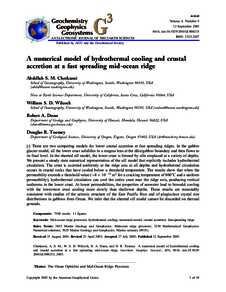Document
A numerical model of hydrothermal cooling and crustal accretion at a fast spreading mid-ocean ridge.
Identifier
DOI: 10.1029/2001GC000215
Source
Geochemistry, Geophysics, Geosystems. v. 4, 9, 8616
Contributors
Country
United Kingdom.
City
Washington
Publisher
The American Geophysical Union
Gregorian
2003-09-01
Language
English
Subject
English abstract
There are two competing models for lower crustal accretion at fast spreading ridges. In the gabbro glacier model, all the lower crust solidifies in a magma lens at the dike/gabbro boundary and then flows to its final level. In the sheeted sill model, the lower crust is formed by sills emplaced at a variety of depths. We present a steady state numerical representation of the sill model that explicitly includes hydrothermal circulation. The crust is accreted uniformly at the ridge axis at all depths and hydrothermal circulation occurs in crustal rocks that have cooled below a threshold temperature. The results show that when the permeability exceeds a threshold value (̃4 × 10 -14 m2 for a cracking temperature of 800°C and a uniform permeability), hydrothermal circulation can cool the entire crust near the ridge axis, producing vertical isotherms in the lower crust. At lower permeabilities, the properties of seawater lead to bimodal cooling with the lowermost crust cooling more slowly than shallower depths. These results are reasonably consistent with studies of the seismic structure of the East Pacific Rise and of plagioclase crystal size distributions in gabbros from Oman. We infer that the sheeted sill model cannot be discarded on thermal grounds.
ISSN
1525-2027
Category
Journal articles


